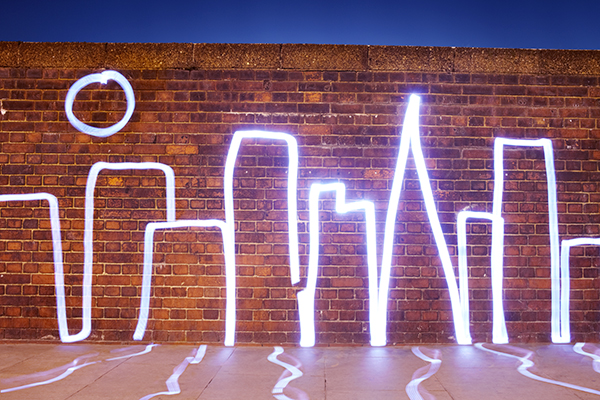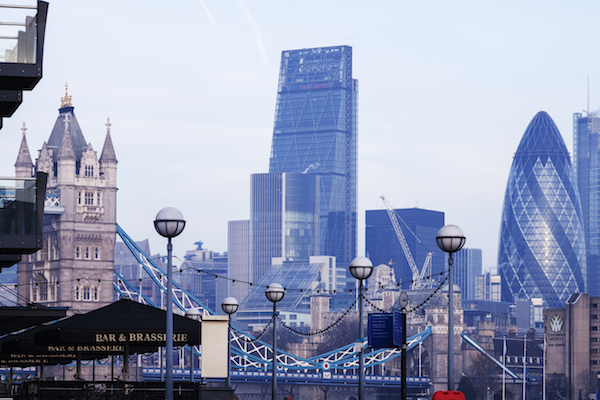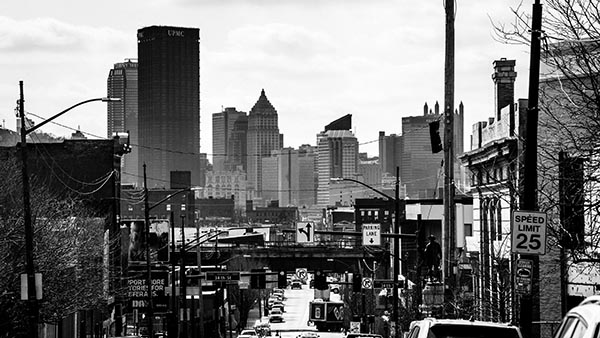With the global urban landscape changing drastically, it’s a good time to ask: what will a ‘good’ city look like in the future?

As home to over half the world’s population and producing more than 80% of global GDP, cities are increasingly significant as engines of national and international change. Projections show that urbanisation combined with overall global population growth could add another 2.5 billion people to urban populations by 2050, with around 90 percent of the increase concentrated in Africa and Asia. The shifting centre of gravity away from a cluster of dominant cities in the northern and western hemispheres towards emerging economies means that by 2025, the composition of the top 600 cities by GDP will change significantly, with one third of developed market cities dropping off the list and 136 new cities in the developing world (the majority in China) entering the top 600.
For the last decade or so, the ‘Smart City’ concept has represented a dominant vision for urban progress across the world, embedding Information and Communications Technologies into the fabric of a city to create a safe, clean, efficient, prosperous urban environment, or a sterile, hyper-controlled, oppressive dystopia, depending on where you’re standing. The smart cities vision has been criticised for being undemocratic, “the wrong idea pitched in the wrong way to the wrong people” – but the conversation has been valuable in revealing what matters to us: discomfort with the idea of a city as a massive robot operated through a control panel exposes deeper concerns about who cities are run by and for whom. In particular what has become clear are the limitations of top-down, tech-driven initiatives run on algorithms that bypass citizen input and take no cognisance of the social and ethical implications of designing a city.
The insights that urban sociology can reveal – about the patterns of people’s lives and behaviour, how they interact with their environment and with each other, the development of culture, and how complex all this can be – need to be embedded into any urban strategy that aims to be ‘wise’ and not just ‘smart’. This includes acknowledging that the attempt to systematise behaviour that is fundamentally unsystematic will be futile; that leaving space for some degree of disorder and unpredictability is crucial; and that the capability of machines to act autonomously doesn’t render our input obsolete.
A city is an inherently political thing, and manifests implicit choices about governance, centres of power, social integration, work, travel, commerce, leisure, and every other facet of communal life. Recognition of this, however, should not obscure the fact that the culture, identity and ethos of a city is determined not by designers but by citizens themselves. Insufficient recognition of where power should lie in city-making is the smart city vision’s greatest shortcoming, and to avoid repeating this mistake it is imperative that humans are placed at the centre of the conversation about the future of cities. Experimenting with such shifts in power is central to the RSA’s work.
Assessing a city
The cities that now steer the global economy have developed over varying timescales and in drastically different ways, but it is possible to identify some common ground in the development arcs of cities across the world, and pinpoint some general conditions for city success and failure.
Amidst a general shift away from ‘old power’ values, characterised by hierarchy, institutionalism, and centralised authority, recent discussions have gone against a traditional tendency to understand cities from a largely hierarchical perspective and begun to take a more holistic view of cities as social and physical ecosystems. Multiple rankings and indices have been created to measure – somewhat tersely – the factors contributing to cities’ global competitiveness. Previously these tended to cluster around economic and institutional metrics such as GDP, productivity, foreign direct investment, and number of international headquarters. Latterly, focus has shifted to factors affecting the liveability of a city, measuring things like affordability of housing, social cohesion, equality coefficients, life expectancy, population health and green spaces. It is in this area that medium-sized cities less commonly considered ‘global leaders’ in economic terms often fare well, such as Berlin, Prague, Philadelphia and Budapest.
The pressure on cities to promote liveability is in part down to the increasing importance of human capital and talent as drivers of future success. It is recognised that talent attracts capital as well as vice versa, and the economic powerhouses that have traditionally dominated as global cities may risk losing out on attracting and retaining talent if they don’t improve on quality of life, social cohesion, affordability, and environmental sustainability. The IESE Cities in Motion Index claims, ‘It must not be forgotten that the human factor is fundamental in the development of cities. Without a participatory and active society, any strategy, however intelligent and comprehensive, will be doomed to failure.’ Investment in technology and jobs are important drivers of sustainable growth, but will only be effective if they are supported by a robust workforce with the skills to harness these developments. As a worldwide shift occurs towards a knowledge-based economy, human capital assumes a more central place in defining a city’s future.
Social dynamics and the built environment
This shift away from understanding cities simply as economic machines has been facilitated by a body of research on urban sociology; specifically, on the link between the built environment and the social life of urban areas. It is here that the limitations of indexed rankings of specific city characteristics become obvious; these measures inevitably silo urban design and social conditions, perceiving them as unrelated factors in determining a city’s success, and furthermore cannot account for how the conditions in cities have changed over time. Evidence abounds that the spatial characteristics of a city have a direct impact upon the social environment at every level, and that this causal relationship has changed in light of other accompanying developments.
Density, for instance – a defining characteristic of urban areas – has historically been problematised as promoting the spread of disease, overcrowding and pollution. However, whilst high-density modern neighbourhoods remain prone to high pedestrian casualties, loss of privacy and sunlight, and urban heat island effects, general improvements in health and sanitation have also opened up the potential for well-designed urban density to support more efficient public transport, reduce per capita emissions, improve energy efficiency in buildings, and create more opportunities for mixed-tenure housing and mixed-use neighbourhoods with better social equality and cohesion.
There is no magic formula for good urban design, but the key is to see the fabric of a city as inextricably bound up with the individual and collective experiences of residents, workers and visitors. Urbanist Jane Jacobs argued in The Death and Life of American Cities that the ‘death’ of urban areas is caused by the elimination of pedestrian activity from city streets, and that urban vitality is fostered by a ‘sidewalk ballet’ made up of a diverse array of people at all times of the day. Well-used pedestrian areas increase public safety, improve health, boost the local economy, and encourage diverse face-to-face interactions; urban spaces must be designed for ease of pedestrian use in order to “make a safety asset … out of the presence of strangers.” It was this belief that drove Jacobs to lead a resistance against city planner Robert Moses’ proposal to construct a four-lane highway through lower Manhattan in the late 1950s.
Jacobs laid out several requirements for the creation and maintenance of urban vitality in American cities (her ideas have also been examined, and found to be applicable, in city contexts as diverse as Florence, Rome and Seoul). First, a district should serve more than one primary function, and ideally more than two. This attracts people with diverse purposes who end up sharing common facilities, and when primary uses are combined in such a way as to attract people at different times of the day, this boosts the local economy and encourages sustained footfall in the area. A district in which various functions flourish, through a combination of offices, retail, housing, and leisure/cultural facilities is likely to attract varied sets of people and sustain a diversified economy.
Diversity of economic activity is also fostered by a variety in the age and use of buildings in a district, which make possible a mixture of high-, medium- and low-income jobs, and a mixture of high- and low-rent tenants in the same area. She observed the changes that New York was undergoing at the time, noting that old and lower-cost buildings helped to cultivate new primary uses in an area (new companies were likely to start and grow in older and lower-rent premises), whilst large-scale buildings did not tend to adapt to their surrounding environment or change much over time.

Jacobs also concluded that street blocks must be short, since large rectangular blocks tend to reduce the effective mixture of use and people, resulting in paths that meet too infrequently. Smaller blocks provide more intersections, thus slowing down traffic, which thwarts urban vitality by discouraging pedestrian presence. Finally, dense concentration of people and buildings creates lively and cultured districts able to attract diverse people for varying purposes. She emphasised that all these factors are necessary and often interdependent in creating a conducive urban environment; mixed land use cannot flourish in low-density areas with large blocks and a homogeneous building stock.
Jacobs highlighted the importance of the human dimensions of cities and the social implications of urban design, examining the city structure as a systematic whole. Christopher Alexander built upon this notion in his work A City is not a Tree, where he argued that patterns of overlap in both social and built structures are essential in creating healthy and vibrant communities. When natural social overlap is overlooked in our built environment, community bonds are eroded and isolation and disassociation occur.
Alexander contrasts the ‘tree’ structure of built spaces with the ‘semi-lattice’ structure of social interactions, arguing that we design our spaces based on tree structures, forcing unnatural stratification of normally complex and intertwined social connections; although our lives and communities are naturally connected in a fluid semi-lattice structure, we nevertheless continue to build our urban spaces in the style of simplified, rigid trees. A city’s poor physical connections can undermine our social connections, and “we would be blind to ignore the intersections of restricted physical mobility with racial segregation and restricted class mobility.”
This is especially the case in American cities, where the geographical spread of different areas and divides between urban and suburban districts compound reliance on cars, rendering mobility the reserve of wealthier citizens, concentrating poverty in particular areas and exacerbating segregation. In other words, physical mobility and social mobility are intertwined in a more literal way than is often acknowledged, and the ability to develop functional communities is often built into the physical fabric of a city.
Richard Sennett saw this process of community building as one of confrontation and sometimes friction, and railed against the sterilisation of urban spaces made possible by new technologies such as the production of sheet glass and made likely by the deification of city architects; the result has been impervious city landscapes and isolated buildings “insulated from sound and touch and other human beings.” Richard Rogers and Anne Power, authors of Cities for a Small Country, also criticise modernist architects for having created urban spaces that are orderly, clean and efficient but socially hermetic and spiritually dead; in this sense adopting a line similar to Sennett’s, whereby the city is seen as the ideal unit for social integration and transcendence of individual status or identity.
Sennett posits the ‘open’ or ‘humane’ city; diverse, complex, untidy in form, “friendly to surprise”, and defined by dissonance and provocation. He articulates the culture of a city as “a matter of experiencing … differences of class, age, race and taste outside the familiar territory of oneself”, and the built environment must be conducive to such interactions and “relatedness among strangers”, not just in a place at a specific point but sustainedly over time. Community bonds develop over long periods and are often ambiguous, organic and unexpected. They require a flexible open system in which to flourish, and it is here that the urban fabric of modern cities often fails to support a functional social milieu. Sennett points to over-determination, both of a city’s visual forms and its social functions: building uses are often singularised or too rigidly specified, rendering them obsolete after a short time. The longevity of modern urban environments is much reduced in comparison to older city structures, with the average lifespan of new public housing in the UK now standing at 40 years, and that of new skyscrapers in New York only 35. This is not just an issue of ephemerality in the physical environment; we must consider the implications of depriving communities of the time and space needed to grow.
The understanding that the city environment profoundly shapes our social experience entails a view of city planning as requiring not just technical knowledge but also a certain ethos. The main flaw of the smart cities rhetoric has been its tendency to ignore the inherently political nature of the city structure, and to avoid repeating this mistake it is important to recognise that whilst algorithms and automated devices can carry out physical tasks and calculations often more safely and efficiently than humans ever could, they cannot deal in the normative issues that called them into existence in the first place. Automation can help a system function smoothly, but there must still be a human hand on the tiller.

Technology and the changing sense of place
Many evaluations that focus on the technological infrastructure of cities (broadband connectivity, investment in telecommunications, etc.) speak of technological connectedness as if it removes a need for physical proximity and spatial efficiency, but this underestimates the importance of communal activity and face-to-face contact. “We are a social species that gets smarter by being around other smart people, and that’s why cities thrive,” claims Edward Glaeser, explaining why companies are still prepared to pay vast ground rents on workspaces in the centre of cities rather than employing remote workers connected only by phone and internet lines, and why workers still spend time and money commuting in order to share a workspace with colleagues.
The ability to communicate across large areas does not make well-designed urban spaces and the option of physical proximity obsolete. How citizens’ sense of place and community is changing against a background of rapid technological development is a relatively new question; how is it possible to harness these developments – which are by definition non-place-specific – to greatest effect, whilst retaining people’s sense of place and connectedness with others? In a 2015 Heartland Monitor poll, 39 percent of respondents agreed that widespread availability and use of technology is diminishing Americans’ quality of life by “isolating people from their neighbours and local businesses, and by weakening the sense of community in our neighbourhoods.”
It is easy to forget that our relationship with digital technology is extremely new and that we are in the midst of an ongoing process of deciding how we want technology to shape our lives and our experiences. Part of this is acknowledging that it is in our hands to mitigate the sense that technology supersedes a need for genuine social connection and a sense of attachment to place, and that the development and use of it should be underpinned by a commitment to enhance rather than supplant these experiences.
As digital technology has become more widely accessible, it has democratised many channels of communication and activity: widening the arena for public discussion, making large amounts of information and content available for free, and enabling free access to learning resources. When technology is harnessed in this way, it can enrich the experiences that connect us to our place and to each other. Think Taskrabbit, RelayRides, Neighborgoods, JustPark – tech-enabled peer-to-peer platforms building on existing trust networks to facilitate the lending and sharing of everything from cars and bikes to skills, pets, and extra space – the ingenuity lies less in the tech itself than in the use of these platforms for forging connections, contributing a skill or resource, saving money, reducing waste, and overhauling the traditional supplier-consumer relationship. Opening up dialogue about cities as places of individual and collective experience, community, decision, and confrontation requires considering what kind of lives we want to live and how our environment and the resources at our disposal can facilitate them.
Social equality and city development
‘Smart growth’ and economic inclusivity is a determinant of a good city, where city leaders identify and nurture opportunities for growth and ensure that all citizens benefit from a city’s prosperity. They must also be realistic about the fact that economic growth presents demands as well as opportunities, requiring investment in human capital, education, work opportunities, and infrastructure in order to be sustainable. With increasing evidence that low human capital and high levels of inequality are conducive to volatile ‘boom and bust’ economic patterns, decision-makers are compelled to consider carefully the practical requirements for securing conditions where ‘smart growth’ can flourish, as well as normative demands of fairness, when attempting to ensure the benefits of prosperity are shared. Stalling economies and extreme inequality can often be attributed to a ‘growth at all costs’ economic approach, or poor management of the demands and benefits of growth.
This is particularly prescient during a period of widespread gentrification in the world’s most prosperous cities, whereby previously deteriorated neighbourhoods undergo a process of regeneration through the influx of affluent residents. In the quest to develop liveable and vibrant urban areas, many cities have become unaffordable to lower-income residents, and often urban regeneration projects have resulted in social and economic displacement.
It is a difficult balance to strike between investing in safer, cleaner urban spaces with desirable cultural assets, and eroding diversity and fairness by pricing out poorer residents, but there are measures that can be taken in cities to ensure that regeneration and inclusivity are not mutually exclusive; possibilities include property tax abatements, zoning ordinances, participatory budgeting, and rent control. Outside of a policy setting, effective responses to gentrification have arisen in the form of community action and coalition-building; many cities have seen cases of eviction threats by property management companies met with resistance from residents and local businesses who have formed community coalitions such as Bizim Kiez in Berlin and East End Trades Guild in London, successfully challenging small business closures, acquisition by developers, and expulsion of residents against a tide of gentrification in the city.
The spread of privately-owned public spaces – ‘pops’ – is feared to be another symptom of corporate figures looming large in the process of urban gentrification. Granary Square in Kings Cross, large swathes of the South Bank and the City of London, Brindleyplace in Birmingham, Liverpool One, and countless parks, gardens and squares in cities far and wide are managed under the jurisdiction of private companies. These spaces are clean and orderly, but we may question the effect that such hyper-managed surroundings have on people’s psyche and behaviour. In particular, what are the implications of an environment designed to recognise the value only of working and spending money? ‘Pops’ often outlaw many of the unstructured, spontaneous behaviours that are fundamental to our civic freedom, so the problem with spaces like these becomes about more than just corporate ownership. The worry is that environments that are monitored, managed and landscaped with the explicit aim of optimising consumer activity are soulless at best, and at worst exclusionary and repressive. The prevalence of privately owned public spaces and their commercialisation of civic life are a strong force powering the shift that Michael Sandel identifies from a market economy to a market society, and resisting this is worth a smattering of chaos. The open, humane city that Richard Sennett envisages, accommodating the full range of civic activity by a broad set of citizens, brings with it a degree of haphazardness that it is neither feasible nor desirable to try to iron out.
Modern cities are often caught between the effects of technocratic over-involvement on the one hand and laissez-faire market tendencies on the other, as the trajectory of city development in general takes on an increasingly neoliberal flavour. The former is manifest in things like ‘pops’, where top-down institutional interventions impose a tidiness that seems to leave no room for cultural creativity and experimentation, and the latter in the creeping commodification of public resources that renders city occupancy the reserve of the wealthy.
The problem with these tandem forces exerting such influence over the development patterns of cities is that together they squeeze the space in which all the things we value most about cities can thrive. Optimised, streamlined systems can overcome challenges that have historically hindered city environments – congestion, dirt, overcrowding, pollution – but it takes more than this to make a city that means something to people; as Usman Haque points out, these initiatives will “make a city bearable, but they don’t make a city valuable.” The culturally animated, humane, interesting parts of a city don’t spring from either hierarchical orderliness or the whims of the free market, and this creates a paradox when considering the design principles of good cities; the elements of cities that people most value don’t appear to be things that can be mandated or designed into an environment. In fact, the notion of something like culture being the result of deliberate effort or intervention by a hierarchy seems incoherent. The difficulty is in finding ways to actively protect the space in which culture and meaning can develop organically whilst avoiding both the hierarchical heavy-handedness and the laissez-faire abstention that can quash the things that make cities valuable. Strong institutions and a dynamic economy are important, but they cannot alone create a city conducive to diversity, creativity, identity, history, and community: which we might consider the ‘deep’ characteristics that make cities attractive places to enrich our lives.

Cities in their nation states
It is important to acknowledge the wider national context in which a city develops. Often when a nation faces a period of slow economic growth or damaged institutional legitimacy, a paradox emerges whereby reliance on cities to sustain the country’s economic activity is part of both the solution and the problem. A heightened dependence on the stability and resilience of urban economies is uncomfortably coupled with a need to address the concomitant chasm between urban and rural areas through redistribution of the financial prosperity that is largely generated in cities. Weathering a prolonged period of sluggish growth, the UK is reliant upon an ever-increasing share of GDP produced in London (projected to be 24.8% by 2022, up from 22.7% in 2015 and 18.7% in 1997) whilst facing heightening pressure to address the prosperity gap between the capital and other parts of the country. This challenge is exacerbated when housing markets, labour markets and demographics fall out of sync between a nation and its largest city.
It is also informative to compare cities within the same nation, to isolate the factors contributing to their success and failure. The Rise and Fall of Urban Economies examines the causes of the disparity between the development of San Francisco and Los Angeles, both large developed cities in resource- and amenity-rich California with diversified manufacturing and service economies, educated workforces and world-leading universities. In 1970, Los Angeles and the Bay Area around San Francisco were fairly similar by many important measures, with a 4% difference in per capita income, and similar levels of innovation, investment, education, and creative jobs. The cities have since experienced divergent patterns of development and today Bay Area outperforms Los Angeles quite significantly in virtually every metric. The difference between the cities’ per capita income is now one third, and whilst the Bay Area has retained its position as the number one US metro area in this respect and grew the ‘Silicon Valley’ capital of global tech, Los Angeles fell from fourth in 1970 to 25th in 2009.
Storper and co. attribute this divergence to seemingly intangible differences in business culture, policy and governance. San Francisco adopted an innovative ‘open source’ culture, opening up channels for movement of people and flow of ideas and capital between companies as well as between business and academic sectors. “Invisible colleges” are key to the Bay Area’s success story: dynamic networks of investors, entrepreneurs and scientists driving joined-up innovation that transcends sector or industry siloes. LA by contrast has exhibited a top-down ‘big dog’ corporate culture, and fallen foul of the misconception that lowering costs and cutting red tape would spell a return to the ‘golden days’ of old-fashioned 20th century big business capitalism, which has fared poorly in comparison with the Bay Area’s “ecosystemic, entrepreneurial, venture-capital-driven, extremely innovative capitalism”. In cultivating low- to medium-wage port and logistics functions over the ‘knowledge economy’ professions championed by San Francisco, Los Angeles leadership may partly have acted in the name of social justice, hoping to provide jobs for low-skilled, low-wage workers and in doing so competing with Texas, Alabama and Mexico – and the high levels of inequality found in San Francisco mean the latter could learn something from this mindset. Economic measures do not tell us everything we need to know about a city, but we can see from this example that effecting real holistic growth and change demands actions across the complex system of businesses, residents, government and educational institutions.
This example emphasises the extremely nuanced and often unpredictable variables that shape the development arc of a city, and the need to understand the city unit as a system of interrelated parts – an ecology wherein autonomous actors (both individual and collective) are connected to one another as well as to organisations, markets and places. An appreciation of this view is relatively modern in urbanist thought, as Sydney Checkland discusses; “Classical economics … had largely dismissed the city, airily treating it, along with the rest of collective behaviour, as part of a Newtonian self-equilibrating system. Thus the city was created and held together by each man going about his business of buying and selling, among other commodities, human labour, either his own or somebody else’s.” It has been established that successful city planning sits at the intersection between many social, economic, technical and architectural considerations, and that taking a laissez-faire view of a city as a self-regulating organism with no need for subjection to conscious direction or normative influence neglects the point of a city in its fullest form. The more holistic view of a city understands the relation between the design of the physical environment and human flourishing, believing that the best urban spaces are those that accommodate individual incentives and actions as well as collective behaviours and the formation and sustainment of communities.
The question of the ‘good’ city is a messy one, and every person will have a slightly different answer. A good starting point is to take a systemic view, recognising the linkages and causality between different elements of the complex city structure. Whilst the smart cities vision appeared to take this approach, joining up big data and digital devices through a vast web run through the ‘internet of things’, it cannot be considered truly systemic because of its routine failure to acknowledge how humans fit into the picture. There are virtually no hard and fast rules about what will make a city ‘good’ in the future, but it is a safe assumption that any city built on a limited view of how humans behave individually and collectively, about their wants and needs, and often disorderly and obstreperous tendencies, is doomed to fail.
With thanks to Matthew Taylor and Jonathan Schifferes for their input on this article
Related articles
-
Glasgow and Pittsburgh: cities of steel
Jamie Cooke
New partnership between two cities with a bright future.
-
4 lessons for the future of lifelong learning
Tom Kenyon
An increase in unemployment will make gaining new skills more important than ever. To make re-skilling work during social distancing, we’ll need to learn to recognise learning wherever it happens.
-
Design principles for democratic innovation
Ed Cox
Ed Cox on the opening of the International Week of Democratic Innovation at the People's History Museum in Manchester.




Be the first to write a comment
Comments
Please login to post a comment or reply
Don't have an account? Click here to register.